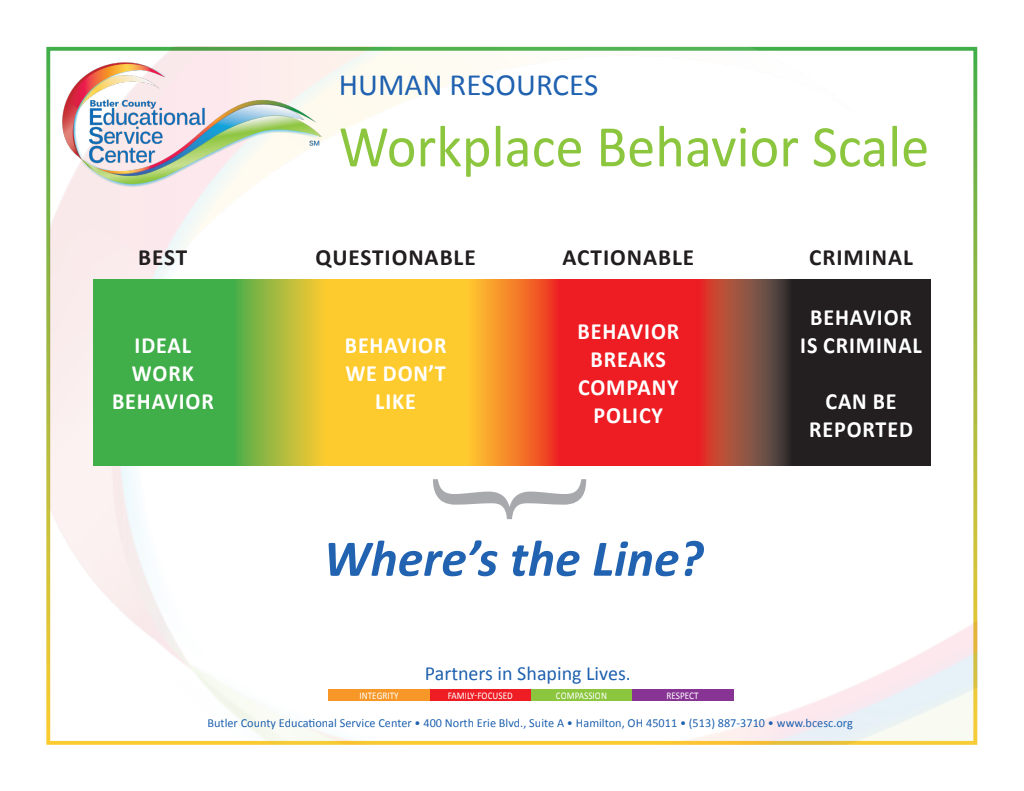Unblurring the Lines: The Workplace Behavior Scale
As Human Resource professionals we are required to know what behaviors are acceptable at work and what behaviors cross the line. The problem is we may view workplace behaviors one way, while employees and administrators look at the same issue differently.. Some may have high expectations for themselves and their staff, while others may be more forgiving or relaxed with what they will accept. It creates a situation where it’s difficult to determine what should be handled by management, and what should be discussed with an HR professional.
This got me thinking about how to explain to employees where I work when it’s appropriate to handle a workplace issue internally, and when to involve HR. I created the Workplace Behavior Scale.
The Workplace Behavior Scale serves two purposes:
- It serves as a starting point in many conversations I have with employees
- It is a guide to help me determine what course of action is best based on the situation
Let’s take a look at all four parts of the Workplace Behavior Scale.
BEST - Ideal Work Behavior
- The goal for all employee behavior
- Contributes to a positive work culture and is not typically reported to the Human Resources office
- Examples: Commending someone on going above and beyond, or recognizing a colleague’s work.
QUESTIONABLE - Behavior we don’t like
- Behavior may or may not cross the line
- Often requires investigation to see if it breaks policy
- May lead to feedback or coaching to address the behavior
- While these behaviors may not specifically break company policy, failure to address them can be a culture killer
- Examples: Negative body language, irritated tone of voice, gossiping, a microaggression (depending on details of the situation).
ACTIONABLE - Behavior the Breaks Company Policy
- Requires Action - such as discipline, retraining, EAP referral, coaching, etc.
- Behaviors are culture killers and often impact others or the department
- Examples: Not following established policies/procedures, a microaggression or repeated microaggressions (depending on details of the situation), or pattern of negative behavior, harassment, discrimination.
CRIMINAL - Behavior that Breaks the Law
- Requires immediate referral to the appropriate authorities
- Team members may need support if they have been impacted by behavior
- Examples: Child abuse or neglect, sexual assualt, theft, etc.
When I share this scale I make clear that HR Professionals usually live in the Questionable and Actionable space. We often serve as the impartial person to gather information, assess and evaluate details, review policy and make recommendations on the most appropriate way to move forward. When employees and supervisors have concerns about staff behavior this visual can serve as a tool to help guide the conversation.
Three benefits of using the Workplace Behavior Scale
- You can help explain that employee behaviors are on a continuum and our role is to gather facts to determine which category the behavior falls . One insensitive comment may not break company policy but a series or pattern of insensitive comments could.
- You can connect the behaviors to company policy. You can share that while someone’s negative non-verbals don’t specifically break company policy, they do indeed conflict with company expectations for culture and therefore need to change.
- You can set expectations about behavior. You are expected to demonstrate professional behavior at work (Green). A negative tone of voice with children and co-workers is unacceptable (Yellow or Red) and needs to stop immediately.
When we can clearly communicate how behaviors and expectations can impact company policies, we improve our Risk Management and Performance Management.
To download a copy of the Workplace Behavior Scale, click here.
